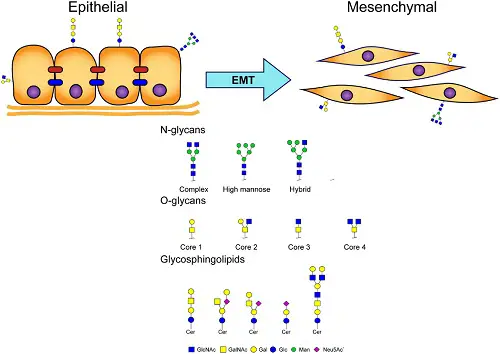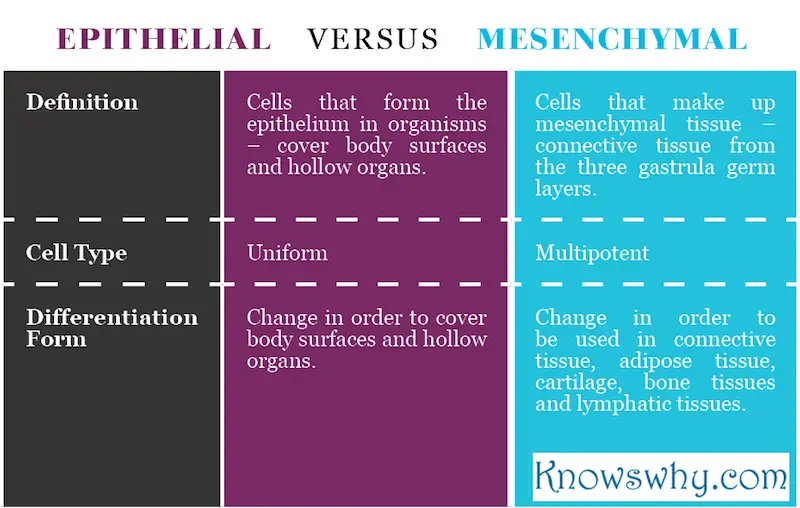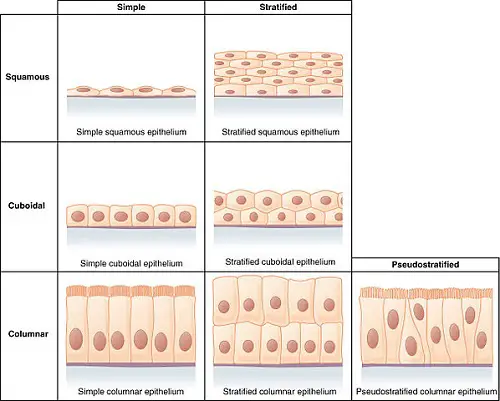Epithelial cells and Characteristics:
Epithelial cells are a uniform cell type, that form the epithelium in organisms. Being stationary, the cells are tightly packed in order to be anchored into the basement membrane. The epithelial cells cover the outside body surfaces, and line any hollow organs within the body, such as respiratory, urogenital and digestive system.
The tissue also forms the lining of body cavities, and can also form glands. Being avascular, epithelial cells do not have blood vessels, and also possess the ability of regeneration through the process of cell division in order to replace any dead cells.
The epithelium is classified by the cell shape, or layer number, of a given cell. When classifying on layer number, three epithelium types are identified – stratified, pseudostratified and simple.
In a simple epithelium, an extension of epithelial cells away from the basement membrane, forms a single layer. When multiple epithelial cell layers are arranged within the epithelium, it is called a stratified epithelium. A pseudostratified epithelium looks to have multiple cell layers, but upon closer inspection, the epithelium is actually connected and attached to the basement membrane.

Mesenchymal cells and Characteristics:
Mesenchymal cells, are a particular group of cells that have similar function and morphology. They make up mesenchymal tissue, which is connective tissue from the three gastrula germ layers. With the ability to differentiate in a variety of different mature cell types, Mesenchymal stem cells are considered multipotent stem cells.
These mesenchymal stem cells differentiate into cells that are required to make connective tissues, adipose tissue, cartilage, bone tissues and lymphatic tissues in adulthood. They are either stellate or fusiform, located between the endoderm and ectoderm of a young embryo, existing in the mesoderm area. The majority of mesenchymal cells will originate in the mesoderm.
The mesenchyme emerges first during gastrulation, as a result of a transitional process known as the mesenchymal-epithelial transition. This basic process occurs during regeneration of the tissue from the embryo. Embryonic mesenchymal cells can become epithelial cells, as can epithelial cells become mesenchymal, with the transition process being reversible. A conversion of epithelial into mesenchymal cells is initiated through a loss of epithelial, adherens junctions, tight junctions and cadherin on epithelial cell membranes.
Cell surface molecules on the epithelial cells, will undergo endocytosis, loosening the shape of the microtubule cytoskeleton, which enables mesenchymal cells the ability of migration along the extracellular matrix. Whenever secondary generation of epithelial tissue is required, a conversion of mesenchymal cells into epithelial cells will occur, showing the reverse transitional process.
Difference between Epithelial and Mesenchymal cells
The key differences between epithelial and mesenchymal cells, is the difference in cell type and the way they differentiate.
Epithelial cells are a uniform cell type, making up the epithelium in the body tissues. Mesenchymal on the other hand, are a multipotent cell type, originating in the mesoderm.
When they differentiate, epithelial cells change in order to cover surfaces on the body and line body cavities and hollow organs. Mesenchymal, differentiate into cells that are used to create connective tissue, adipose tissue, cartilage, bone tissues and lymphatic tissues.
Table of comparison to show the difference between Epithelial and Mesenchymal cells:

Summary
Both epithelial and mesenchymal cells are differentiated vertebrate cell types. Epithelial cells are uniform and adhere tightly to one another to form the epithelium tissue. This epithelium is a protective layer that covers body cavities and surfaces.
Mesenchymal cells are a multipotent cell type, and originate in the mesoderm. The Mesenchymal stem cells, can differentiate into a variety of different cell types, and change into cells that are required in order to create connective tissues, adipose tissue, cartilage, bone tissue and lymphatic tissues in adulthood. This represents the key difference between the two types of cells – the ability to differentiate into different cells.
Author: Alex Hammond
Alexander Hammond hold a first-class master’s degree in Ecology. He has conducted a number of international research projects in Indonesia, Belize and the UK, in the areas of Marine Biology, Terrestrial Ecology and Conservation. Several of his research reports have been published.











Leave a Reply